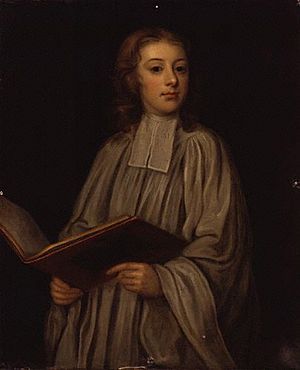William Croft facts for kids
William Croft was an important English composer and organist. He lived a long time ago, from 1678 to 1727. He wrote many pieces, especially for churches. His music is still played and loved today.
Contents
William Croft's Early Life and Training
William Croft was born in a place called Nether Ettington in Warwickshire, England. He was baptised on December 30, 1678.
When he was young, he went to the Chapel Royal. This was a special group of musicians who performed for the King or Queen. There, he learned music from a famous teacher named John Blow. Croft stayed at the Chapel Royal until 1698, learning and growing as a musician.
Becoming an Organist
After leaving the Chapel Royal, Croft became an organist. In 1700, he started working at St. Anne's Church, Soho. He also became an organist and a "Gentleman extraordinary" at the Chapel Royal. He shared this important job with his friend, Jeremiah Clarke.
In 1700, Croft worked with another musician, probably Gottfried Finger. They created six sonatas together. Sonatas are pieces of music for instruments like the violin, flute, harpsichord, and viol. They were written in a new, popular style from Italy.
Working at Westminster Abbey
Later, William Croft took over from his old teacher, John Blow. Blow had passed away, and Croft became the organist at Westminster Abbey. This is a very famous church in London.
Croft wrote music for important events. He composed pieces for the funeral of Queen Anne in 1714. He also wrote music for the special ceremony when King George I became king in 1715.
William Croft's Famous Music
In 1724, Croft published a collection of his church music called Musica Sacra. This was the first time such a collection was printed as a full score. It included a special Burial Service. This service might have been written for Queen Anne or for the Duke of Marlborough.
Sadly, Croft's health got worse after this. He passed away in Bath, England, when he was 48 years old.
The "St Anne" Hymn Tune
One of Croft's most well-known pieces is the hymn tune called "St Anne." A hymn tune is the melody for a church song. He wrote it for the famous poem Our God, Our Help in Ages Past by Isaac Watts.
Other composers liked this tune so much that they used it in their own music. For example, Handel used it in his anthem O Praise the Lord. Hubert Parry also used it in his 1911 Coronation Te Deum. Even Johann Sebastian Bach's Fugue in E-flat major is sometimes called the "St. Anne" because its main tune sounds similar.
The Funeral Sentences
Perhaps Croft's most important work is his suite of Funeral Sentences. These are a set of musical pieces that have been called "a glorious work of near genius." They were first published as part of the Burial Service in Musica Sacra.
The seven Sentences are verses from the Bible. They are meant to be sung or said during an Anglican funeral. One of these sentences, Thou knowest, Lord, the secrets of our hearts, was not written by Croft. It was composed by Henry Purcell for Queen Mary's funeral in 1695.
Croft's Funeral Sentences have been used in every British state funeral since they were published. They were sung at the funeral of George Frideric Handel in 1759. More recently, they were used at the funerals of important figures like Winston Churchill in 1965, Diana, Princess of Wales in 1997, and Queen Elizabeth II in 2022.


